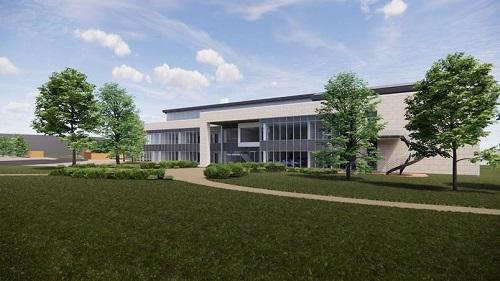Through the construction of a sustainable, multi-tenanted office and laboratory building, the new development will provide space for new life sciences companies, and for existing companies to grow, enabling the UK to continue to compete in the global life sciences sector.
South Cambridgeshire District Council’s Planning Committee approved the application at its Planning Committee on 8 December 2021, but the decision was subject to referral to the Secretary of State, due to being a major development on green belt land. The site, which is around 2.5 hectares in size, is currently grassland. The Secretary of State had the option to ‘call in’ the judgement, to make the decision himself, but has confirmed this month that he does not wish to call in the decision. This means the decision by councillors stands, and the decision was formally issued on Thursday 13 January.
The Babraham Research Campus – which is strategically supported by the Biotechnology and Biological Sciences Research Council (BBSRC) – enables world leading, ground-breaking bioscience research and business to come together in a unique combination, through its co-location of bioscience companies – of which there are 60+ currently on site – with the world leading discovery research of the Babraham Institute. This distinct focus accelerates scientific discovery and helps to build and scale businesses. The result is a highly connected, sustainable and dynamic ecosystem and a community of scientists and entrepreneurs that attracts exceptional people and talent, creates new discoveries, therapeutics, jobs and growth to support the UK economy.
The new facility is expected to support 174 new jobs on site, including through the construction phase and the companies that service the Campus. It’s also proposed that the development would have a net effect of at least £5.74m in Gross Value Added (GVA) in the Greater Cambridge area.
The new two-storey building will be located to the west of the Campus and is set to deliver a high level of energy efficiency (a BREEAM ‘Excellent’ rating is being targeted), achieving up to a 30 to 40% Carbon Dioxide reduction (depending on the measurement used) – which significantly exceeds the current minimum planning requirements of 10%. The proposal also sets out a number of ecological enhancements to improve the quality of the site for native plants and wildlife – resulting in a significant Biodiversity Net Gain of over 20%.
Cllr Pippa Heylings, Chair of South Cambridgeshire District Council’s Planning Committee, said: “There must be very special circumstances to allow development to take place within the green belt, and the applicant presented a range of circumstances which the Committee felt were of such national – and global – importance and public benefit, as to outweigh the harm. The Babraham Research Campus is a local, national and global success story and this expansion will allow them to continue carrying out the incredibly important work that they do there. Additional to the very special circumstances presented, the Committee welcomed the high standards adopted in the design of the Campus which go beyond current requirements and are an example of excellence that we would like to see in all developments. Of particular note, the excellent rating for energy efficiency, carbon reduction and significant enhancement of biodiversity. All of this offered a compelling argument that enabled us to support the development.”
Derek Jones, CEO, Babraham Research Campus Ltd added: “Our dynamic, highly connected Campus ecosystem creates a low-risk environment in which people can share knowledge, skills and scientific capabilities to help create the medicines and businesses of tomorrow. This has resulted in an enterprising and collaborative culture that supports people and their development and facilitates the discovery of treatments and technologies and the understanding of fundamental biology which will have a real impact on the health of future generations.
“The Campus has an increasingly important role to play in stimulating, developing and sustaining local, regional and national economic growth and if this valuable economic contribution is to be enhanced, we must grow to accommodate the changing needs and increasing demand of the fast paced, competitive life science sector. Approval of this latest development is an extremely positive forward step – with thanks to all who have helped make it happen – which will enable us to continue to support the growth of both existing and new innovative ventures within the cluster, without the need for them to look elsewhere.”
Image: Artist’s impression, front view from northwest
